1940-1949
1941 Cadillac - Part 3
- Details
- Written by Big Block
- Category: 1940-1949
- Hits: 4655
1941 Cadillac - Part 3
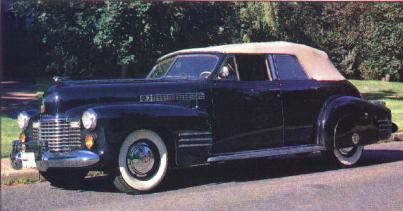 The 1938-41 Sixty-Special was unquestionably a design tour de force, but we shouldn't forget its performance, which was -- and still is -- just as impressive. Beginning in 1937, Cadillac had settled on the 346-cid version of the monobloc V-8 for all its eight-cylinder models except LaSalle. Rated at 135 horsepower at 3400 rpm, the 346 had five more horses than the 1935 V-8 and 10 more than the one-year-only 322-cid monobloc. The Sixty-Special arrived weighing only some 230 pounds more than a comparable 1938 Series 60 sedan, so its power-to-weight ratio was less than 31 pounds per horsepower, quite good for the period.
The 1938-41 Sixty-Special was unquestionably a design tour de force, but we shouldn't forget its performance, which was -- and still is -- just as impressive. Beginning in 1937, Cadillac had settled on the 346-cid version of the monobloc V-8 for all its eight-cylinder models except LaSalle. Rated at 135 horsepower at 3400 rpm, the 346 had five more horses than the 1935 V-8 and 10 more than the one-year-only 322-cid monobloc. The Sixty-Special arrived weighing only some 230 pounds more than a comparable 1938 Series 60 sedan, so its power-to-weight ratio was less than 31 pounds per horsepower, quite good for the period. 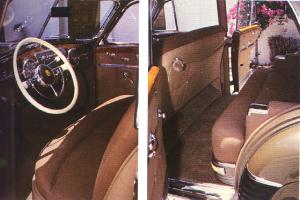 By contrast, that year's Packard Super Eight -- which, incidentally, cost $700 more than the Special -- carried nearly 35 pounds per horsepower. The 346 continued without change until 1941, when higher compression pushed output to 150 bhp, more than enough to offset the restyled Special's slight weight gain. Thus, Cadillac's posh "compact" was a good performer as well as a styling leader, as rewarding to drive as it was pleasing to look at.
By contrast, that year's Packard Super Eight -- which, incidentally, cost $700 more than the Special -- carried nearly 35 pounds per horsepower. The 346 continued without change until 1941, when higher compression pushed output to 150 bhp, more than enough to offset the restyled Special's slight weight gain. Thus, Cadillac's posh "compact" was a good performer as well as a styling leader, as rewarding to drive as it was pleasing to look at.
The durable monobloc V-8 would go to war, powering the U.S. Army's M-5 and M-24 tanks that would mean so much to the Allies. Hydra-Matic, an exclusive Cadillac option new for '41, also saw action in these tanks. Engineer Harry Barr would later recall that the transmission was very serviceable right from the start, and the improvements resulting from four years of military service would make the postwar versions even better.
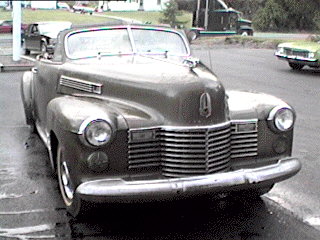
Even as the winds of war were blowing, Cadillac was preparing to phase out the Sixty-Special, at least as Mitchell had originally conceived it. To be sure, the 1942 lineup had a model bearing that designation, but it was of another breed. Replacing the distinctively styled 1938-41 design with its unique bodyshell was simply a stretched, though beautifully finished, version of the Series 62 four-door, utilizing the massive new C-body that Cadillac shared with Buick and Olds. There was nothing wrong with that, of course. The Sixty-Special of that abbreviated model year was as impressive as ever, as indeed it would be in the postwar era. But it was no longer quite so "special," a difference that has not been lost on today's collectors. While a fully restored '41 now brings around $23,000 -- perhaps $1000 more if it happens to have a sunroof -- the '42 is worth no more than $10,000 in comparable condition and the postwar continuations go for even less.
The Sixty-Special became even less special in the Fifties and Sixties. Usually it was just a Series 62 or DeVille four-door with more ornate exterior trim and interior furnishings, though it did retain the exclusive 133-inch wheelbase adopted for 1942 all the way through 1958. Even the name was progressively watered down, and it disappeared completely in favor of the Fleetwood Brougham label with the advent of Cadillac's first downsized big cars for 1977. But the original Sixty-Special and its sporting, slightly raffish character would never be forgotten on Clark Avenue. As Mitchell himself suggests, its spiritual descendant is today's Seville, the enormously successful compact Cadillac, introduced in 1975.

So the Sixty-Special and its great heritage lives on, in current Cadillac’s and in the many 1938-41 originals lovingly preserved by their proud owners. The undeniable influence of its design -- and the inspired hand of its designer -- can be seen in most of the better-looking automobiles produced over the last 40-odd years, and that's as it should be. As the last sentence of Cadillac's oft-quoted 1914 "Penalty of Leadership" ad reminds us: "That which deserves to live -- lives."
For 1941, the Series 61 designation was brought back, replacing LaSalle in the Cadillac price structure. A new Series 63 was offered in one body style. A new Series 67, with Fisher sedan bodies and the longest wheelbase (139 in.) replaced the 1940 Series 72. For the first time since 1926, all Cadillac products used the same engine.
Front end stylists adopted a theme which was to be repeated for years to come. The one piece hood came down lower in front, included the side panels, and extended sideways to the fenders. A single, rectangular panel of louver trim was used on each side of the hood. Access to the engine compartment was improved, to say the least. The rectangular grill was wide, vertical, and bulged forward in the middle. Rectangular parking lights were built into the top outer corners of the grille. Headlights were built into the nose of the fenders, and provision for built in accessory fog lights was proved under the headlights. Three chrome spears were on the rear section of all four fenders, except on the Sixty Special. Rear wheel shields (fender skirts) were standard on most bodies.
Sixty special front fenders extended into the front doors Series 61 Coupe and Sedan were fastback styles reminiscent of the Aerodynamic coupes of the Thirties. Series 62 came in the standard body style lineup, including the only Convertible Sedan for 1941 and the last such body style offered by Cadillac. Running boards were concealed or no-cost options on all but the 60S and 75; the Sixty Special had none and the 75s had nothing but. Power tops, electric divisions, factory installed air conditioning, and Hydra-Matic transmissions were available. Serial numbers were located on the left frame side bar, opposite the steering gear. Starting number: Same as the engine number. Ending number: Same as engine number. Engine numbers were on the crankcase, just behind the left cylinder block parallel to the dash.
| Model | Beginning serial number | Ending serial number |
| Series 41-60S | 6340001 | 6344101 |
| Series 41-61 | 5340001 | 5369258 |
| Series 41-62 | 8340001 | 8364734 |
| Series 41-63 | 7340001 | 7345050 |
| Series 41-67 | 9340001 | 9340922 |
| Series 41-75 | 3340001 | 3342101 |
SPECIFICATIONS
STYLE | |||||
| Style No. | Body Type | Seating | Price | Weight | Production |
| Fleetwood Series 41-60S, 126 in. wheelbase | |||||
41-6019S | Sedan | 5 pass. | $2195 | 4230 | 4101 |
41-6019S-A | Sedan (STT) | 5 pass | -- | -- | |
41-60195-F | Sedan (Dlv) | 5 pass | $2345 | 4290 | |
| Fisher Series 41-61, 126 in wheelbase | |||||
41-6127 | Coupe | 5 pass | $1345 | 3985 | 29,258 |
41-6127D | Coupe Deluxe | 5 pass | $1435 | 4005 | |
41-6109 | Touring sedan | 5 pass | $1445 | 4065 | |
41-6109D | Touring Sedan Deluxe | 5 pass | $1535 | 4085 | |
| Fisher Series 41-62, 126 in. wheelbase | |||||
41-6227 | Coupe | 2/4 pass | $1420 | 3950 | 24,734 |
41-6227D | Coupe Deluxe | 2/4 pass | $1510 | 3970 | |
41-6219 | Touring Sedan | 5 pass | $1495 | 4030 | |
41-6219D | Touring Sedan Deluxe | 5 pass | $1535 | 4050 | |
41-6267D | Convertible Coupe Deluxe | 2/4 pass | $1645 | 4055 | |
41-6229D | Convertible Sedan Deluxe | 5 pass | $1965 | 4230 | |
| Fisher Series 41-63, 126 in. wheelbase | |||||
41-6319 | Touring sedan | 5 pass | $1696 | 4140 | 5050 |
| Fisher Series 41-67, 139 in wheelbase | |||||
41-6719 | Touring sedan | 5 pass | $2595 | 4555 | 922 |
41-6719-F | Touring sedan (Div. window) | 5 pass | $2745 | 4615 | |
41-6723 | Touring sedan | 7 pass | $2735 | 4630 | |
41-6733 | Imperial Touring sedan | 7 pass | $2890 | 4705 | |
| Fleetwood Series 41-75, 136 in. wheelbase | |||||
41-7519 | Touring sedan | 5 pass | $2995 | 4750 | 2104 |
41-7519-F | Touring sedan (Div. window) | 5 pass | $3150 | 4810 | |
41-7523 | Touring sedan | 7 pass | $3140 | 4800 | |
41-7533 | Touring Imperial | 7 pass | $3295 | 4860 | |
41-7559 | Formal sedan | 5 pass | $3920 | 4900 | |
41-7533-F | Formal sedan | 7 pass | $4045 | 4915 | |
| Business Cars Series 41-74, 136 in. wheelbase | |||||
41-7523-L | Business Touring sedan | 9 pass | $2895 | 4750 | included in above total |
41-7533-L | Business Touring Imperial | 9 pass | $3050 | 4810 | |
ENGINE | |
Engine type | Ninety degree, L-Head, 8-cylinders |
Engine block | Cast iron block (blocks cast enbloc with crankcase) |
Bore & Stroke | 3.50 x 4.50 in (88.9 mm x 114.3 mm) |
Displacement | 346 cu. in. (7.095 lit) |
Compression ratio | 7.25 : 1 |
Brake horsepower | 150 @ 3400 RPM |
SAE/Taxaable horsepower | 39.20 |
Main bearings | three |
Valve lifters | hydraulic |
Carburetor | Stromberg AAV-26, Carter WDO 506s |
CHASSIS | |||||
| Model | Wheelbase | Overall length | Front Tread | Rear Tread | Tires |
| Series 41-6OS | 126 in. | 217.375 in. | 59 in | 63 in | 7.00 x 15 |
| Series 41-61 | 126 in | 215 in | 59 in | 63 in | 7.00 x 15 |
| Series 41-62 | 126 in | 216 in | 59 in | 63 in | 7.00 x 15 |
| Series 41-63 | 126 in | 215 in | 59 in | 63 in | 7.00 x 15 |
| Series 41-67 | 139 in | 228 in | 58.5 in | 62.5 in | 7.50 x 16 |
| Series 41-75 | 136 in | 226.125 in | 58.5 in | 62.5 in | 7.50 x 16 |
| Series 41-62 commercial chassis | 163 in | 252.875 in | - | - | 7.00 x 16 |
| Series 41-75 commercial chassis | 163 in | 252.875 in | - | - | 7.50 x 16 |
TECHNICAL | |
| Transmission | Selective synchro manual transmission |
| Speeds | 3 forward, 1 reverse |
| Drive position | Left hand drive (Right hand optional except on 60S and 67) |
| Gearshift location | On column |
| Clutch | Single disc |
| Drive | Shaft drive |
| Rear axle | Hotchkiss, semifloating rear axle, hypoid gears |
| Overall ratio (60S, 61, 62, 63) | 3.77 : 1 (opt. 3.36 : 1) |
| Overall ratio (67, 75) | 4.27 : 1 (opt. 3.77 : 1) |
| Brakes | Hydraulic brakes on four wheels |
| Wheels | Slotted disc wheels |
| Wheel size | 15 in. (16 in on 67 and 75) |
| Drivetrain options | Automatic transmission ($125.00), Hill-holder (Norol) $11.50 |
OPTIONS | |
| Fender skirts | $17.50/pair |
| Radio | $69.50 |
| Heater | $59.50 - 65.00 |
| Seat covers | $8.75/seat |
| Spotlight | $18.50 |
| Fog lights | $14.50 |
| Backup light | $7.50 |
| Windshield washer | $7.50 |
| Wheel discs | $4.00 each |
| Trim rings | $1.50 each |
The 1941 model was introduced September, 1940. The general manager of Cadillac was Nicholas Dreystadt
1941 Cadillac - Part 2
- Details
- Written by Big Block
- Category: 1940-1949
- Hits: 3087
1941 Cadillac Part 2

The '41 Caddy was the first luxury automobile with a fully automatic transmission, four-speed Hydra-Matic, which had been pioneered by Oldsmobile in 1940. About 30 percent of production came equipped this way for '41, and that would double the next year, and more than triple postwar.  The '41 model year also saw the introduction of air conditioning as a Cadillac option. Truly, this was a big step from the classic era into the modem age -- even though only 300 cars were equipped with the bulky apparatus that occupied a considerable amount of space throughout the car. In fact, the unit had no automatic clutch and could be disengaged only by removing the belt in the engine compartment. By comparison, Packard had advertised its "Weather-Conditioner" as early as February 1940, and it was every bit as bulky and primitive as the Cadillac arrangement.
The '41 model year also saw the introduction of air conditioning as a Cadillac option. Truly, this was a big step from the classic era into the modem age -- even though only 300 cars were equipped with the bulky apparatus that occupied a considerable amount of space throughout the car. In fact, the unit had no automatic clutch and could be disengaged only by removing the belt in the engine compartment. By comparison, Packard had advertised its "Weather-Conditioner" as early as February 1940, and it was every bit as bulky and primitive as the Cadillac arrangement. 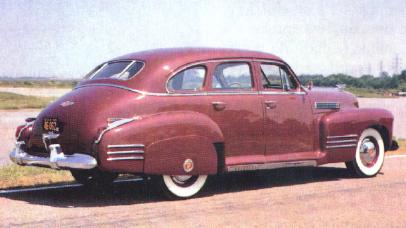 As noted above, Cadillac frequently used the word "economy" in describing its cars, and backed it up by pointing out that the '41 engine was 15 percent more economical than the 1940 unit. The brochure noted that "Strict tests prove the Cadillac Sixty-One capable of delivering fourteen miles to the gallon -- far and away the best proven economy record in its field." An illustration graphically showed that the same amount of fuel required for a '41 Caddy to travel from Los Angeles to New York would leave the '40 model stranded 400 miles shy of the "Big Apple." The conclusion was that "Plainly -- a Cadillac is one of the thriftiest investments you can make."
As noted above, Cadillac frequently used the word "economy" in describing its cars, and backed it up by pointing out that the '41 engine was 15 percent more economical than the 1940 unit. The brochure noted that "Strict tests prove the Cadillac Sixty-One capable of delivering fourteen miles to the gallon -- far and away the best proven economy record in its field." An illustration graphically showed that the same amount of fuel required for a '41 Caddy to travel from Los Angeles to New York would leave the '40 model stranded 400 miles shy of the "Big Apple." The conclusion was that "Plainly -- a Cadillac is one of the thriftiest investments you can make."
Performance wasn't neglected, either. Cadillac claimed that its 346-cid V-8 had undergone "hundreds of improvements," including a higher 7.25:1 compression ratio (up from 6.25:1 and 6.70:1 in 1940). The changes boosted output of the L-head unit to 150 horsepower at 3400 rpm, enough to propel the lightest models from 0-60 mph in about 15 seconds, and from 0-30 in about four. Safety wasn't overlooked either, as directional signals were standard equipment, unusual in 1941.
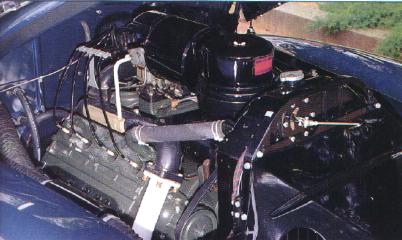
Styling was heavily emphasized for '41, and the new Cadillac’s emerged looking quite distinctive. The prow-nose motif of the Thirties was gone, replaced by a blunter and more massive frontal design that was highlighted by a dramatic horizontal eggcrate grille -- a theme that has been continued to this day. That, plus the coffin-nose-style hood (evidence of the industry-wide effect of Cord styling), and the headlights integrated into the broader fenders, separated it from all Cadillac’s that had gone before. Meanwhile, a three-piece front bumper guard (one horizontal) provided a cove to protect the license plate, and provision was made for extra-cost fog lights under the headlights (cars without them sported round emblems with a "V" in their center).
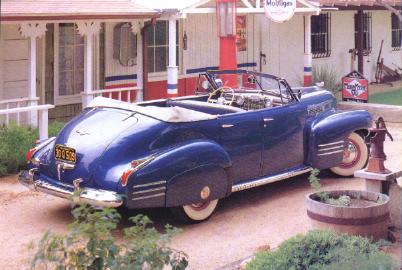
At the rear, fenders were squarer, the left taillight hid the gas-filler cap, and on most models twin vertical bars divided the rear window into three segments. A large circle medallion on the fender skirts and three horizontal chrome "speed stripes" on the front and rear fenders of most models also set the cars apart from previous Cadillac’s. The Sixty Special, however, lacked the last two decorative items as Mitchell deliberately avoided superfluous ornamentation on this model. Seeing the Sixty Special in a lineup of other Mitchell-designed cars, one can quickly sense his touch, which emphasized clean, smooth, youthful lines -- whether on a 1963 Corvette Sting Ray or the '41 Sixty Special.

The extensive styling changes of the '41 models, along with improving economic conditions, helped Cadillac set a production record in 1941: 66,130 units. Apparently Cadillac's moves to consolidate its range were bearing fruit. By 1941, the economy was recovering nicely, largely on the strength of stepped-up military production, which was already under way even though the United States had not yet been drawn into the widening Second World War. With inflation starting to make itself felt, Cadillac boosted prices for its all-new 1941 models. The Sixty-Special, which had listed at $2090 ever since 1938, went up to $2195, yet it was still a bargain. And with the demise of the massive Sixteen after 1940, it was now the flagship of the fleet, the cream of the crop that firmly established Cadillac as America's ultimate automotive status symbol.
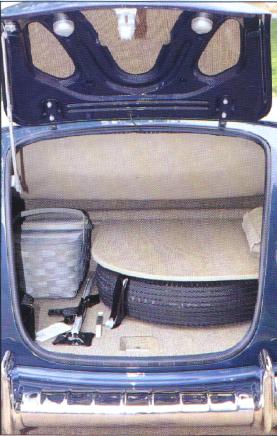
Styling was again the keynote throughout the 1941 line, fastidiously derived from that of the original Sixty-Special but with deft touches that would be followed by the rest of the industry post haste. These cars reeked class -- so well-executed that even their heavy use of chrome didn't seem at all garish or inappropriate. The Special retained its crisply formal look, while "torpedo" styling was applied to most other models. Headlamps were now mounted in, rather than on top of, the front fenders. In between was a horizontal eggcrate grille, the first use of a Cadillac hallmark that's still with us. Fenders acquired squared-off trailing edges that harmonized nicely with both the torpedo bodies and the Special's foursquare contours. The Special's front fenders were swept back into the front doors, a forecast of 1942, and the new front-end sheet metal blended so well with the 1938-40 central structure that the '41 looked totally new and completely contemporary.

Cadillac's 1941 model lineup was considerably -- and shrewdly -- realigned. The companion LaSalle was discarded, and the Series 61 returned to take its place. The 62 remained the volume series, offering a full range of body styles, including convertible coupe and sedan. A bit further up the price ladder was a lone four-door under the new Series 63 designation. Wheelbase on the Sixty-Special was shaved an inch, to 126 inches, to match that of the three lower-priced lines. At the top of the heap were the 138-inch-wheelbase Series 67 and 136-inch Series 75 models. Accessories abounded: radios, fender skirts, driving lights, mirrors, windshield washer, backup lamps, and new Hydra-Matic self-shift transmission were all available.
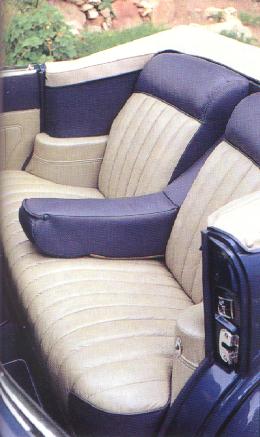
The Series 61 and 62 were priced substantially less than any Cadillac of recent memory -- as little as $1345 for the standard 61 coupe. Befitting its name, the Special was still at $2195 for the base four-door, and suffered a small production loss (about 500 units) from the previous year. Yet mainly due to the success of the two lower series, the division nearly doubled its production for model year 1941 compared to combined 1940 Cadillac/LaSalle volume. Interestingly, that was accomplished without major mechanical changes. The one significant under-the-skin alteration for '41 was a more rigid frame designed for a smoother ride on all types of roads.
1941 Cadillac - Part 1
- Details
- Written by Big Block
- Category: 1940-1949
- Hits: 2943
1941 Cadillac - Part 1
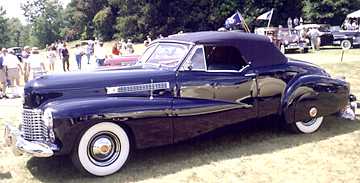 Although both the LaSalle and the V-16 were dropped, Cadillac nonetheless offered a wide range of restyled models for 1941. An eggcrate grille that would become a Cadillac trademark was new, as well as Hydra-Matic automatic transmission. With good looks and solid engineering, Cadillac was about to strengthen its hold on the luxury market. In 1941, General Motors' prestige division proudly proclaimed that "For thirty-nine years, Cadillac's manufacturing policy has remained one of the few certain things in an uncertain world. The organization, at its inception, decided to give its name only to the finest motor cars it was possible to produce. That ideal has never changed. Today, as always, the sole pre-occupation of Cadillac engineers and craftsmen is with perfection. And Cadillac and Cadillac owners have thereby gained a rich reward."
Although both the LaSalle and the V-16 were dropped, Cadillac nonetheless offered a wide range of restyled models for 1941. An eggcrate grille that would become a Cadillac trademark was new, as well as Hydra-Matic automatic transmission. With good looks and solid engineering, Cadillac was about to strengthen its hold on the luxury market. In 1941, General Motors' prestige division proudly proclaimed that "For thirty-nine years, Cadillac's manufacturing policy has remained one of the few certain things in an uncertain world. The organization, at its inception, decided to give its name only to the finest motor cars it was possible to produce. That ideal has never changed. Today, as always, the sole pre-occupation of Cadillac engineers and craftsmen is with perfection. And Cadillac and Cadillac owners have thereby gained a rich reward." 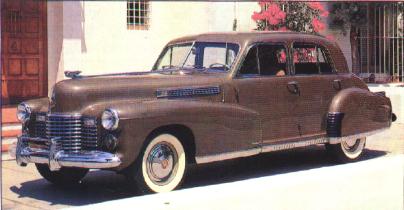 That quest for perfection, along with the breath of fresh air young William L. "Bill" Mitchell gave Cadillac design in the late Thirties, helped the marque emerge from the Depression with its reputation as the "Standard of the World" finally intact. One of the most desired automobiles on earth, buyers at the time would walk right by a Rolls-Royce or Mercedes-Benz -- or a Packard -- if they could have a Cadillac instead. Indeed, Cadillac boasted in 1941 that "In the field above two thousand dollars, approximately two-thirds of all motorists make Cadillac their choice."
That quest for perfection, along with the breath of fresh air young William L. "Bill" Mitchell gave Cadillac design in the late Thirties, helped the marque emerge from the Depression with its reputation as the "Standard of the World" finally intact. One of the most desired automobiles on earth, buyers at the time would walk right by a Rolls-Royce or Mercedes-Benz -- or a Packard -- if they could have a Cadillac instead. Indeed, Cadillac boasted in 1941 that "In the field above two thousand dollars, approximately two-thirds of all motorists make Cadillac their choice."
Buyers knew that Cadillac was a solid, reliable, and beautiful car that would arouse the envy of their neighbors -- and it was American in the best sense of the word. One of the oldest of the Detroit marques, Cadillac had continually asserted its leadership in engineering. Most notably, it had won the Royal Automobile Club's Certificate of Performance in a closely supervised test in 1908, demonstrating for the first time true automotive parts interchangeability. And Cadillac was first with a mass-produced V-8, this in 1915. These developments exhibited good old American ingenuity and innovation at its best, and Americans were quick to appreciate the sound quality that went into a Cadillac.
Later, Bill Mitchell's 1938 Cadillac Sixty Special set the automotive world abuzz. It was such a surprisingly crisp and imaginative design that it is a marvel to behold even today. Then Mitchell pulled another rabbit out of the hat with his 1941 Sixty Special design, judged by some as Cadillac's all-time best.
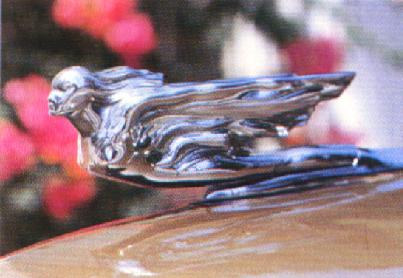
As the Forties dawned, however, it became clear that consolidation was to be a major factor for Cadillac during the new decade. And the attitude at Cadillac was decidedly forward-looking, causing the old ways to be pushed aside -- side-mounted spares were last offered in 1940, for example, and the convertible sedan would disappear a year later. More to the point, both the V-16 and the LaSalle, Cadillac's "companion make," were eliminated after 1940.
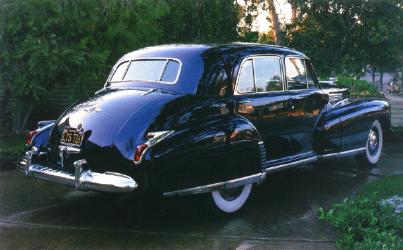
Quite unfairly, the LaSalle had acquired the reputation of being a "cheap" Cadillac. Actually, it was no more a cheap Cadillac than a Bentley was/is a cheap Rolls-Royce. However, the LaSalle was a several-hundred-dollar step down in price from Cadillac in the GM hierarchy. Cadillac therefore compensated with a bottom-of-the-line Series Sixty-One for 1941. The coupe started at just $105 above the least expensive '40 LaSalle, thus filling LaSalle's rung in the GM "price ladder." Even though replaced, thought was given several times over the following decades to revive the LaSalle name. In the early Sixties, it was considered by Bill Mitchell for what became the '63 Buick Riviera. The name was brought up again when the design for the 1975 Seville, Cadillac's first "compact," was being developed. Early clay models of both cars bore LaSalle badges.
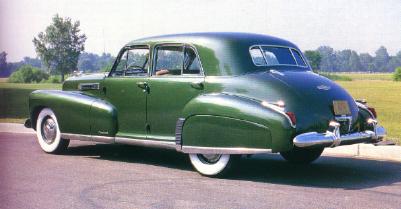
The phasing out of the V-16, which in any event was selling in minuscule numbers, allowed Cadillac to devote its full energies to the old "one make-one engine" idea that had prevailed at the division prior to the LaSalle's 1927 debut. The 346-cubic-inch V-8 thus became the engine for all models through 1948. These moves didn't mean that luxury was abandoned, however -- they simply meant that great changes were afoot at the Cadillac Motor Car Division.

Even with the addition of the Series Sixty-One for 1941, the loss of the Sixteen’s meant that the model count dropped from 39 in 1940 to 26 for '41 (although the number of series increased from five to six), and for 1946 Cadillac would further consolidate its range to 11 models in four series. But in 1941, the lineup was confusing enough that Cadillac devoted considerable space in its catalog to describe it.
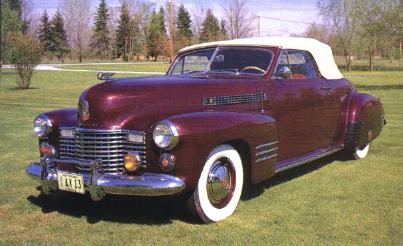
The price-leader Series Sixty-One was touted as "one of the finest and most powerful Cadillac’s ever built -- yet . . . priced in the medium-price range, and challenges small cars for economy. . . . Anyone who pays above a thousand dollars for a car should plan on owning a Cadillac." The six-model Series Sixty-Two was "the Cadillac version of popular 'Torpedo' styling. Its cost is moderate and economy is remarkable." The Sixty-Three, "available only as a Five-Passenger Touring Sedan -- is a completely new and exclusive body design. With matchless beauty it combines unusual economy. It is the 'Sixty Special' of its field." All of the above models shared a 126-inch wheelbase. Riding a 139-inch span, the four Series Sixty-Seven models were "built specifically for motorists who want exceptional size and luxury without excessive cost." Sharing their body shells with the Buick Limited, they seated five or seven passengers.
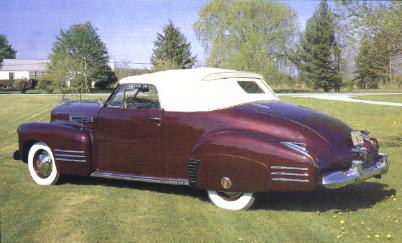
Two series were designated as Fleetwood’s for 1941. The three-model Fleetwood Sixty Special, on the 126-inch chassis, was "built especially for those who seek appearance and performance distinct from those of any other motor car. In design and engineering it is truly 'special' in every sense of the word."
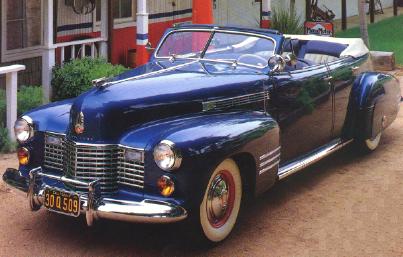
Finally, the eight Fleetwood Seventy-Five sedans, all on a 136-inch wheelbase, had seating configurations for five, seven, or nine. Further, they came with or without the glass "Imperial Division," which was electrically powered (also available on the Sixty Special and Series Sixty-Seven). The Seventy-Five was also available on a 163-inch-wheelbase commercial chassis. Compared to 1940, the Series Ninety (V-16) and Seventy-Two were gone, but the Series Sixty-One, Sixty-Three, and Sixty-Seven were new. 
The price range for the '41 Cadillac’s was wide, but not nearly as expansive as in 1940. For example, the '40 Sixteen seven-passenger Town Car had listed at $7175, whereas the most expensive '41 was the Fleetwood Series Seventy-Five Formal Sedan, a seven-seater, at $4045. On the other hand, one could purchase the bottom-of-the-line Series Sixty-One Coupe for $1345, just $63 more than a Buick Roadmaster coupe, but $340 less than the cheapest '40 Cadillac.
The Sixty-One was no dog, either, boasting unique fastback styling that was later copied by Bentley -- not to mention the copycats within GM and at other American producers. Its design theme harked back to 1934-37, when Cadillac had produced a limited number of high-priced fastbacks, called Aero-Dynamic coupes. Due in part to the attractive fastback shape, the standard Sixty-One coupe was the best selling model in the '41 Cadillac lineup (11,812 units), while the standard four-door came in second (10,925). It's hardly surprising, then, that fastbacks were continued through the 1949 model year. By 1950, however, Cadillac decided that the hardtop was the way to go, leaving the fastback a distinctive memory of the Forties.
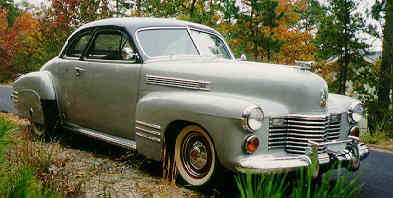
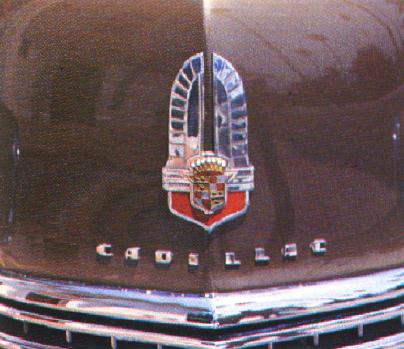

1940 Cadillac
- Details
- Written by Big Block
- Category: 1940-1949
- Hits: 4747
1940 Cadillac
Of all the automobiles of the late prewar era, few were as beautiful as the Cadillac Sixty Special of 1938-41. And none was more significant from the standpoint of styling.
Back in 1936, Cadillac had introduced, in the Series Sixty, not just a new model but a new class of motorcar. More luxurious, more powerful and more expensive than the Packard One-Twenty and the other "premium" medium-priced cars, it was nevertheless about 30% cheaper than the least expensive 1935 Cadillac. Powered by a brand new monobloc V-8, the Sixty was a quality product, a Cadillac through and through. Yet -- thanks to the judicious use of components commandeered from other General Motors divisions -- it was priced as low as $1645.
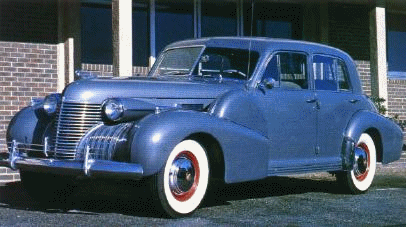 Not surprisingly, the Series Sixty paced Cadillac to a whopping 254% sales increase during its maiden year. Equally significant during the 1936 season was the arrival at Cadillac of a new chief designer, 23-year-old Bill Mitchell, the man who would ultimately replace the great Harley Earl as head of styling for General Motors. Mitchell, looking ahead to the 1938 season, began to think in terms of a high-fashion, up-market version of the Sixty. And with Harley Earl's blessing he set about to bring that concept to reality.
Not surprisingly, the Series Sixty paced Cadillac to a whopping 254% sales increase during its maiden year. Equally significant during the 1936 season was the arrival at Cadillac of a new chief designer, 23-year-old Bill Mitchell, the man who would ultimately replace the great Harley Earl as head of styling for General Motors. Mitchell, looking ahead to the 1938 season, began to think in terms of a high-fashion, up-market version of the Sixty. And with Harley Earl's blessing he set about to bring that concept to reality. 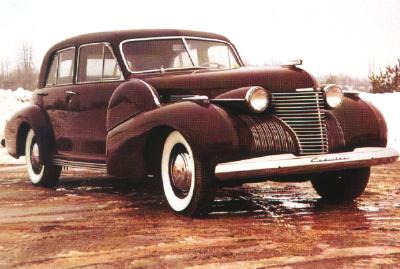
As the new model began to take shape, some Cadillac officials became nervous. Don Ahrens, head of sales at the time, later recalled his own misgivings: "I do not need to remind automobile men," he had said, "that the Cadillac market is ultra-conservative. The bulk of our business is conducted with sound and substantial families. How would this revolutionary car affect our position in the industry? Was it too startling for our price class? Was it too rakish for our reputation?"
And indeed the Sixty Special was revolutionary, startling and even rakish.
- Running boards were eliminated. A very daring move that enabled Mitchell to widen the body to the full tread of the wheels, thus providing more spacious accommodations.
- Overall height was lowered by three inches, with no loss of headroom. A good idea, obviously; but certainly a break with Cadillac's staid traditions
- The low belt line, tall windows and slim pillars provided a markedly different visual effect, one that would later come to be associated with hardtop" styling, though in this instance a slim center pillar was retained
- Chrome trim was sparingly applied, in contrast to the customary practice of supplying lots of flashy bright work
- Pontoon-shaped fenders, borrowed no doubt from the 1934-36 LaSalle, gave the car a massive appearance and added to the illusion of length
- All four doors were front-hinged, a long-overdue idea, fated to be widely copied in the years ahead
- An extended deck, a "first" for a production automobile, transformed the trunk from a clumsy add-on to an attractive styling feature
It was radical, no doubt about that. Yet the Sixty Special was tastefully done, strikingly handsome and, in the years that followed, widely imitated.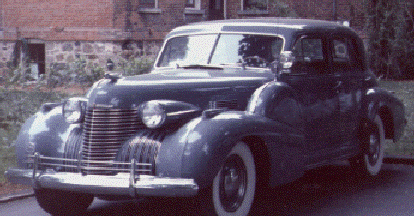
The copywriters had a field day. "There has never been a car like the Cadillac Sixty Special," they enthused. "A car with such definite modernity of line, yet so obviously right in taste ... a precedent-breaking car prophetic of motor cars not yet on other drawing boards, yet a car wholly devoid of freakish trappings."
Copywriters are paid for their high-flying hyperbole, of course; but in this instance they weren't far off the mark. For the Sixty Special represented the first of the "specialty" cars -- high-styled and premium-priced models that would come in later years from many manufacturers. Cars, for instance, like the Lincoln Continental; and other designs by Bill Mitchell himself, such as the 1963 Buick Riviera and the original front-wheel-drive Eldorado.

Still, there was cause for concern. For 1938 was a recession year, and Cadillac found itself introducing this daringly different new automobile into a severely depressed market. And its appeal was restricted by the fact that it was built only in a single body style, a four-door, four-light sedan. Selling as it did, at a premium of nearly 25 percent over the price of the mechanically identical Series Sixty, the new car faced an uncertain future.
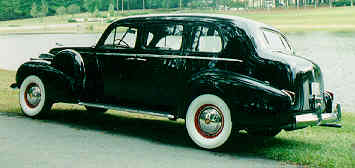
Or so it was thought. But the public loved the Sixty Special. Loved it so much, in fact, that it out-sold the cheaper Series Sixty sedan by a margin of nearly three to one.
To the original, single model two variants were added for 1939. One of these featured a sun roof, while the other was a formal Imperial type, complete with divider window. And by 1940 there was even a pair of Sixty Special town cars, offering a choice of leather or metal-backed top. Styling was little changed, apart from an aggressive prow-shaped grille, introduced for 1939 and continued the following year with minor alterations.
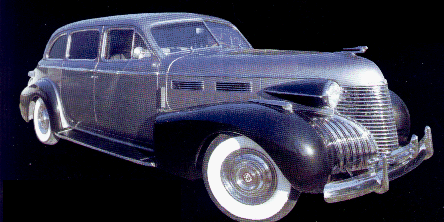
Sales for 1939 eclipsed those of the Sixty Special's initial year. But Cadillac's new Series 62 stole a little of the Sixty Special's thunder in 1940. It was another Bill Mitchell design, a stunning one, utilizing the new, bustle-backed General Motors "C" body, a configuration that had clearly been inspired by the Sixty Special. Offering more than a touch of the latter's styling for substantially less money, the 62 naturally cut into the sales of the more expensive car, replacing it as Cadillac's best-seller.
A dramatically re-styled front end (which some critics thought was too heavy) characterized the 1941 model. But again it proved to be a trendsetter, with long sweeping front fenders that extended back onto the doors. Even the grille presaged the frontal appearance of Cadillac’s yet to come. But sales of the Sixty Special slipped a little further. 
Bill Mitchell's stunning styling theme had run its course; the fickle public was ready for something different. It came in the form of a new Sixty Special for 1942. Basically a stretched, upscale version of the 62, this one simply didn't have the panache of its predecessors. It is noteworthy that among today's collectors the 1942 version is worth scarcely more than a third as much as the 1938 original.
Two more versions of the basic sedan appeared among Sixty-Special offerings for 1940, and all models now carried Fleetwood instead of Fisher bodywork for the first time. The Imperial Sedan could now be ordered without the sunroof, and a new Town Car style was added in both steel- and leather-backed forms -- at a hefty surcharge over the standard version. Styling on all Cadillac’s stayed mostly the same except for heavier horizontal grille bars, slightly less restrained use of bright metal and, along with most other American cars that year, standardization of sealed-beam headlamps.
Arriving in the price bracket just below the Special was the new Series 62, a replacement for the 61 featuring two predictive "torpedo" body styles fresh from the Art & Colour studio, a sedan and a five-passenger coupe. The 62 stole some of the Special's thunder. Another Bill Mitchell design, it employed GM's new C-body, with lines obviously inspired by the Special. This together with prices that were some 16 percent lower -- enabled the 62 to oust the Special as Cadillac's volume leader for 1940.
Cadillac had settled on the 346-cid version of the monobloc V-8 for all its eight-cylinder models except LaSalle beginning in 1937. Rated at 135 horsepower at 3400 rpm, the 346 had five more horses than the 1935 V-8 and 10 more than the one-year-only 322-cid monobloc. The Sixty-Special arrived weighing only some 230 pounds more than a comparable 1938 Series 60 sedan, so its power-to-weight ratio was less than 31 pounds per horsepower, quite good for the period. By contrast, that year's Packard Super Eight -- which, incidentally, cost $700 more than the Special -- carried nearly 35 pounds per horsepower.
For 1940, Series 61 was replaced by Series 62, featuring the "Projectile" or "torpedo" bodies. The one-year-only Series 72 was introduced as a less expensive companion to the series 75. 1940 was the final year for optional side mounts.
The identifying feature for all V-8 Cadillac’s was once again the grille.
Although the grilles were the same pointed shaped as in 1939, the grille bars were heavier and fewer in number. Two sets of louver bars appeared on each hood side panel. Sixty special was available as a Town Car as well as a Sedan Series 62 featured a low sleek body with chrome window reveals, more slant to the windshield, and a curved rear window. Running boards were no- cost options. Convertible Coupes and Sedans were introduced in midyear.
Series 72 had the general appearance of the Series 75, but was three inches shorter and was set apart by rectangular tail lights set high on the sides of the trunk. Re-circulating ball steering was tried on Series 72 in 1940, to be adopted on all series in 1941.
Sealed beam headlights and turn indicators were standard equipment. The engine manifold was set at five degrees to the engine to cancel the rearward tilt of the engine and give balanced fuel distribution. Serial numbers were located on the left frame side bar, opposite the steering gear. The starting and ending numbers were the same as the engine numbers.
The engine number was located on the crankcase, just behind the left cylinder block, parallel to the dash.
Introduced in October, 1939, the general manager of Cadillac was Nicholas Dreystadt.
SPECIFICATIONS
| Model | Beginning serial number | Ending serial number |
| Series 40-60S | 6320001 | 6324600 |
| Series 40-62 | 8320001 | 8325903 |
| Series 40-72 | 7320001 | 7321525 |
| Series 40-75 | 3320001 | 3320956 |
| STYLE |
| Style Number | Style | Seating | Price | Weight | Production |
| Fleetwood Series 40-60S, 127 in. wheelbase | |||||
40-6019S | Special Sedan | 5 pass. | $2090 | 4070 | 4600 |
40-6019S-A | Sedan (STT) | 5 pass | -- | -- | |
40-60195-F | Sedan (Dlv) | 5 pass | $2230 | 4290 | |
40-6053S | Town Car | 5 pass | $- | - | - |
40-6053-LB | Town Car | 5 pass | $3820 | 4365 | - |
40-6053-MB | Town Car | 5 pass | $3465 | 4365 | - |
| Fisher Series 40-62, 129 in wheelbase | |||||
40-6219 | Touring Sedan | 5 pass | $1745 | 4030 | 5903 |
40-6227C | Coupe | 5 pass | $1685 | 3940 | |
40-6229 | Convertible Sedan | 5 pass | $2195 | 4230 | |
40-6267 | Convertible Coupe | 2 pass | $1795 | 4045 | |
| Fleetwood series 40-72, 138 in. wheelbase | |||||
40-7219 | Touring Sedan | 5 pass | $2670 | 4670 | 1525 |
40-7219-F | Touring Sedan (Div) | 5 pass | $2790 | 4710 | |
40-7223 | Touring Sedan | 7 pass | $2785 | 4700 | |
40-7233 | Imperial Sedan | 7 pass | $2916 | 4740 | |
40-7259 | Formal Sedan | 5 pass | $3695 | 4670 | |
40-7233-F | Formal Sedan | 7 pass | $3695 | 4780 | |
| Fleetwood Series 40-72, 138 in. wheelbase Business Cars | |||||
40-7223-L | Business Touring sedan | 9 pass | $2690 | 4700 | Included in total above |
40-7233-L | Business Touring Imperial | 9 pass | $2824 | 4740 | |
| Fleetwood Series 40-75, 141 in wheelbase | |||||
40-7557 | Coupe | 2 pass | $3280 | 4785 | 956 |
40-7557-B | Coupe | 5 pass | $3380 | 4915 | |
40-7567 | Convertible Coupe | 2 pass | $3380 | 4915 | |
40-7519 | Sedan | 5 pass | $2995 | 4900 | |
40-7519-F | Imperial sedan | 5 pass | $3155 | 4940 | - |
40-7559 | Formal Sedan | 5 pass | $3995 | 4900 | - |
40-7539 | Town sedan | 5 pass | $3635 | 4935 | - |
40-7529 | Convertible sedan | 5 pass | $3945 | 5110 | - |
40-7523 | Sedan | 7 pass | $3210 | 4930 | - |
40-7533 | Imperial sedan | 7 pass | $3360 | 4970 | - |
40-7533-F | Formal sedan | 7 pass | $3995 | 4970 | - |
40-7553 | Town Car | 7 pass | $5115 | 5195 | - |
$4045 | 4915 | ||||
$4045 | 4915 | ||||
| Fleetwood Series 40-75, 141 in. wheelbase Business Cars | |||||
40-7523-L | Business Touring sedan | 8 pass | $- | - | included in above total |
40-7533-L | Business Touring Imperial | 8 pass | $- | - | |
| ENGINE |
Engine type | Ninety degree, L-Head, 8-cylinders |
Engine block | Cast iron block (blocks cast enbloc with crankcase) |
Bore & Stroke | 3.50 x 4.50 in (88.9 mm x 114.3 mm) |
Displacement | 346 cu. in. (7.095 lit) |
Compression ratio | (Series 60S, 62) 6.25:1, (Series 72, 75) 6.7:1 |
Brake horsepower | 135 @ 3400 RPM, (140@3400 on 72, 75) |
SAE/Taxaable horsepower | 39.20 |
Main bearings | three |
Valve lifters | hydraulic |
Carburetor | Stromberg AAV-26 |
| CHASSIS |
| Model | Wheelbase | Overall length | Front Tread | Rear Tread | Tires |
| Series 40-60S | 127 in. | 216.875 in. | 58 in | 61 in | 7.00 x 16 |
| Series 40-62S | 129 in | 216.0625 in | 58 in | 59 in | 7.00 x 16 |
| Series 40-72S | 138 in | 226.6875 in | 58 in | 62.5 in | 7.50 x 16 |
| Series 40-75 | 141 in | 228.1875 in | 60.5 in | 62.5 in | 7.50 x 16 |
| Series 40-72 commercial chassis | 165.25 in | 253.8125 in | - | - | 7.50 x 16 |
| Series 40-75 commercial chassis | 161.375 in | 248.6875 in | - | - | 7.50 x 16 |
| TECHNICAL |
| Transmission | Selective synchro manual transmission |
| Speeds | 3 forward, 1 reverse |
| Drive position | Left hand drive (Right hand drive optional) |
| Gearshift location | On column |
| Clutch | Single disc |
| Drive | Shaft drive |
| Rear axle | Hotchkiss, semifloating rear axle, hypoid gears |
| Overall ratio (60S, 61, 62) | 3.92 : 1 |
| Overall ratio (72) | 4.31 : 1 |
| Overall ratio (75) | 4.58 : 1 |
| Brakes | Hydraulic brakes on four wheels |
| Wheels | Slotted disc wheels |
| Wheel size | 16 in |
| Drivetrain options | Hill-holder (Norol) $13.50 |
| OPTIONS |
| Fender skirts | $17.50/pair |
| Radio | $69.50 |
| Heater | $26.50 - 52.50 |
| Seat covers | $8.25/seat |
| Spotlight | $18.50 |
| Automatic battery filler | $7.50 |
| Flexible steering wheel | $15.00 |
| Fog lights | $14.50/pair |
| Windshield washer | $6.50 |
| Wheel discs | $4.00 each |
| Trim rings | $1.50 each |
Page 2 of 2